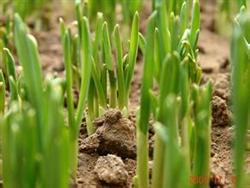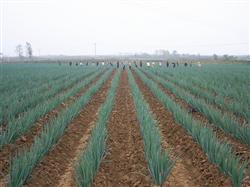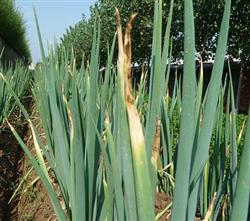Seedling raising technique of Welsh Onion

First, the variety selection mainly includes star F1, Yuanzang, Changbao, Hanchun F1 and other Japanese imported varieties; domestic varieties: rare jade giant onion, iron pole, Moyu giant onion, Zhangqiu green onion and so on. Second, the sowing date and seedling age should choose loose and fertile land with high organic quality. Because green onions avoid continuous cropping, the plots planted with onion and garlic crops in the previous crop can not be used. The imported precocious varieties were sown in the first ten days of March and harvested from the end of October to the early January of the following year, while those in the field were sown at the end of March and early April and harvested from November to January of the following year. The mid-maturing varieties were sown in early April, harvested from January to February, and mastered the seedling age of 50-55 days. The late-maturing varieties were sown in mid-late April, harvested at the end of February and early March, and mastered the seedling age of 50-55 days. According to the different harvest time, domestic varieties can be raised in small arch shed in March and April, in the open air in May, June, September and October, and in greenhouse in October and November. Third, seed preparation in nursery bed is expensive, so seedlings should be raised and transplanted in production. The seedbed should choose the sandy loam soil with loose and fertile soil, flat terrain and convenient drainage and irrigation, which have not been planted with onions and garlic in the previous 3 years, and turn deep into the sun every other year. For the preparation of nutritious soil, it is required to choose 6 parts of vegetable garden soil that has not been planted with onions in 3 years and 3 parts of fully mature organic fertilizer, mash and mix well. Prepare the land 5-7 days before sowing. According to the soil fertility, 20 kg of organic fertilizer and 8 kg of compound fertilizer were applied in 80 square meters, which were scattered evenly on the border surface and fully mixed with the soil. In order to prevent the damage of underground pests, phoxim EC 75 Mel 100 g, plus 4 Mel 5 times water, mixed wheat bran 1.5 kg, sprinkled evenly on the border surface, shallow hoe, then raked flat, followed by pedal again, to prevent uneven irrigation, uneven soil cover and affect the emergence of seedlings, and finally watering and sowing. Fourth, soak the seeds and use the new seeds of the same year, 200 grams per mu of green onions. Soak the seeds for disinfection before sowing, method 1: soak the seeds with 40% formaldehyde 300x solution for 3 hours, rinse with clean water after soaking, which can prevent purple spot disease; method 2: soak the seeds with 0.2% potassium permanganate solution for 25 minutes, then rinse with clean water, which can kill the pathogens on the seed surface; method 3: wrap the seeds in clean gauze and soak them in 50 ℃ of warm water for 30 minutes. Shake constantly when soaking so that the seeds are heated evenly. After soaking, rinse it with clean water and soak it in 20 murmur30 ℃ for 2 hours, then sow seeds after waterlogging. After seed soaking, the seeds can emerge 1 or 2 days ahead of schedule. 5. Sowing, raising seedlings and sowing. Before sowing, sufficient bottom water is poured into the bed. After the water has fully seeped, the seeds are evenly sown with fine dry soil or fine sand. After sowing, the soil thickness is 0.5ml / cm, and then covered with plastic film or arched shed to increase temperature and preserve soil moisture. Keep the soil moisture sufficient. When the onion sprouts are exposed, remove the plastic film immediately. The temperature from seed germination to cotyledon elongation should be above 7 ℃, and the optimum temperature is 20 ℃. Remove the plastic film in time when the emergence of seedlings reaches more than 60%. The proper temperature of the first true leaf was 1725 ℃ before transplanting. Do a good job of inter-seedling work, the first time to remove the seedlings with higher density, the second time to fix the seedlings, to get rid of diseased seedlings of inferior quality. When the seedlings have 2-3 leaves, combined with watering, topdressing 1-2 kg urea or compound fertilizer. The turning green water at seedling stage should not be carried out prematurely, but should be carried out when the daily average temperature is above 13 ℃, so as to avoid the decrease of ground temperature and the yellowing of onion leaves. Those who pour overwintering water without topdressing fertilizer before overwintering can be combined with returning green water to apply returning green fertilizer, that is, "seedling fertilizer" to promote the growth of seedlings. Then pay attention to squatting seedlings to promote root growth. After 15 days of squatting seedlings, the seedlings entered the vigorous growth period, and the growth rate was significantly speeded up. The times of irrigation should be gradually increased, and about 3-5 kg urea per mu should be applied to meet the growth needs of the seedling stage. However, 10-15 days before planting, attention should be paid to controlling fertilizer and water to prevent onion seedlings from becoming tender and the survival rate decreased after planting. When the onion seedlings have 89 leaves, you should stop watering and prepare the seedlings for planting. In principle, herbicides are not used in green onion seedling bed, but in the later stage of seedling cultivation, if there are too many weeds, we can consider the appropriate use of herbicides such as high-efficiency herbicide to kill weeds. The seeds for raising seedlings per mu can be planted in the field of about 7-8 mu. Sixth, the prevention and control of diseases and insect pests should be carried out at the seedling stage by diligent observation, early detection and early prevention and control, so as to ensure that the seedlings are complete, complete and strong. The main diseases in the seedling stage are Blight and Botrytis cinerea, which can be sprayed with 50% carbendazim wettable powder 1500-2000 times at the initial stage. Green onion downy mildew can be sprayed with chlorothalonil, carbendazim, nail cream copper, disinfectant alum, aluminum ethyl phosphate and high efficiency onion. Viral diseases are transmitted by piercing and sucking mouthparts insects (such as aphids), so attention should be paid to prevention and control. The main pests in seedling stage are onion horse and leaf miner, which can be sprayed with 1.8% avermectin EC 2000 times and 10% imidacloprid wettable powder 1000 times.
- Prev

Technical guidance on cultivation of Welsh Onion
First, raising seedlings: 1. Sowing time: according to the different requirements of the products, the seeds can be sown in four seasons. The best sowing time for high-yield Welsh onion is autumn sowing (the ten-day average temperature is 16.5 ℃-17 ℃, which is in the first ten days of October). The climatic conditions of the north and south of the country are different, the sowing time is also different, the best time is determined.
- Next

Fertilization techniques for High quality and High yield of Welsh Onion
The cause of root rot of Welsh onion is similar to that of retting root, and it is a fungal disease. It is a disease caused by Pythium, Fusarium oxysporum, Phytophthora and other pathogens. The pathogen overwintered in the soil or on the diseased body and became the main source of primary infection the following year. The pathogen invaded from the rhizome or root wound and entered through Rain Water or irrigation water.
Related
- Where is it suitable to grow horseradish in China? it is expected to see the middle altitude horseradish in Alishan.
- How to prevent tomato virus disease reasonably? (Control methods included)
- Many people like to plant towel gourd on the balcony. What are the main points of this method and management?
- What crops can chili peppers be mixed with?
- Fertilization techniques and matters needing attention in Tomato
- What are the grafting techniques for peach seedlings in spring?
- Harm and control methods of root swelling disease of Chinese cabbage
- What are the pests of sweet potatoes? How to prevent and cure it?
- Symptoms, causes and Control methods of navel Rot in Tomato
- The cause of "Cucumber rotten bibcock" in Farmers' planting Cucumber and its Control Plan

